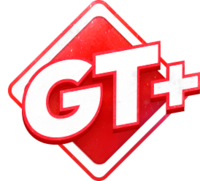On the PokerCode channel, Fedor Holz delivered a 3-bet game plan for anyone struggling with these concepts. GGPoker's newest Integrity Ambassador was very thorough and used GTO Wizard to illustrate the concepts for viewers.
Fedor Holz: The main things for 3-bet pots to consider, especially preflop, are the position, the stack size, the stage of the tournament. Generally, you have a solid foundation and understanding of the spot, especially if you want to exploit, and then later, we make adjustments to live games.
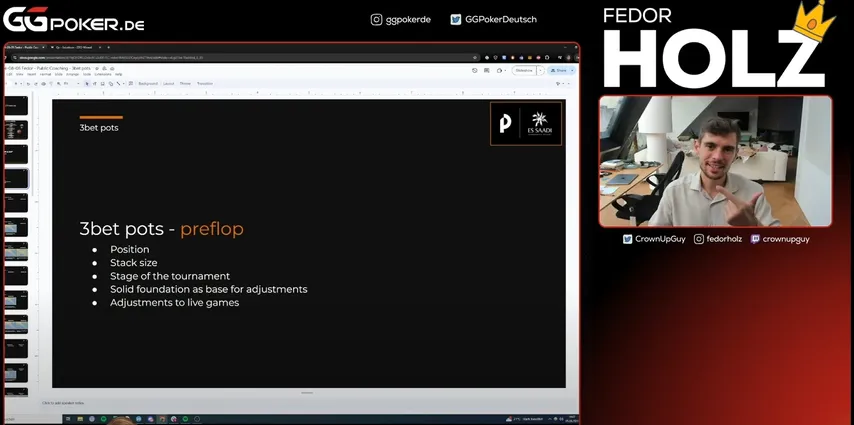
Polarized vs Linear 3-Bet Ranges
I want to jump right into comparing 3-bet pots and the range morphology when we look at different positions. So now here on the left side, we can see 60 big blinds cutoff versus hijack. Okay, so we are in position, hijack opens, it's a semi-common situation.
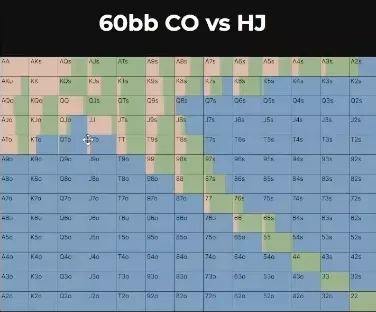
Now we look at our range and what we see is we have a somewhat polarized range. Right, makes a lot of sense. We still have profitable calls and the reason why we build our range this way is because those calls, you generally have this sandwich situation where the best hands want a 3-bet well because they get called by worse, the medium hands want to call because they keep in the slightly worse hands and you dominate some stuff and you realize your equity. You don't want to fold to a 4-bet. Then the slightly worse hands 3-bet because they fold out slightly better, especially in the offsuit range, and they still have playability postflop.
So you want to go slightly polarized and call the stuff in the middle, and then you call some weaker stuff again or just hands that have better playability in calling such as pairs, for example. So this is how it looks like.
How do you think this is going to look different small blind versus cutoff? The consensus of chat is less calling and more 3-betting. So let's take a look.
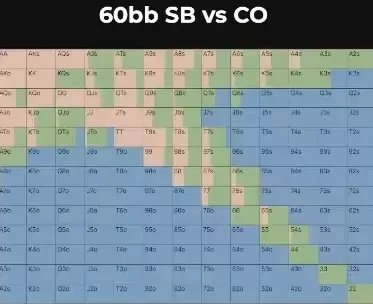
Not bad, not bad. The interesting part though is the thing that you haven't really said is if you look at the overall range, we play a wider range. So technically it's not really less calling by that much in percent. I actually didn't write down the percent so if we look at percent we call 15% and raise 12 and I think the spot before was this: we call 12 and raise 8.6. So technically speaking, I mean those are not the perfect two situations to compare. It's one is open cutoff, one is open hijack, the other one is open cutoff. So let's just maybe take a look at hijack open. You know we can look at cutoff and then we can compare to small blind.
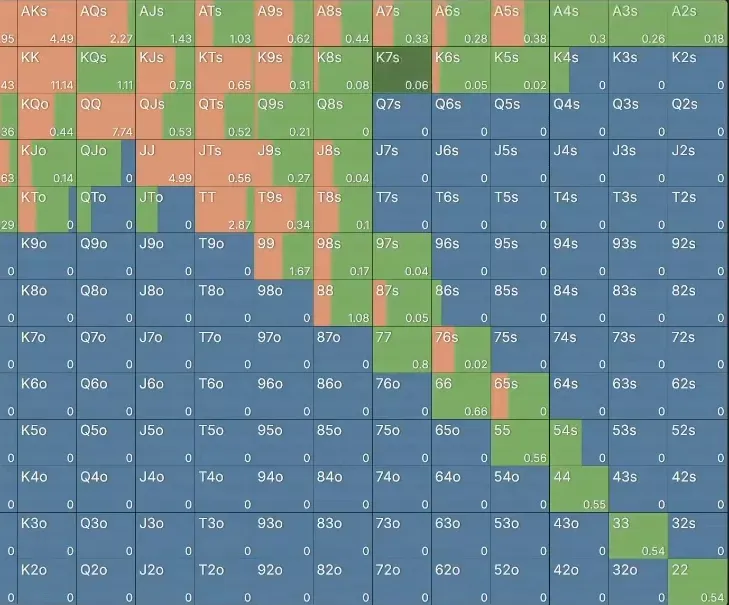
Nevertheless, what we see and I think where basically chat was wrong – it's more calling and it's more 3-betting. So the point when you look at cutoff versus hijack, it's just less people behind us and we also have half a big blind in the middle and that leads to us just being able to play wider range. Definitely, the thing that has been said more linear 3-betting is kind of correct. So we definitely 3-bet more linear, it's slightly more polarized, we get called a little bit more. So in-position equity realization is different, so less incentivization to flat and that just increases this linear 3-betting more. So there's just no flatting with the hand like Ace-Jack off.
Now what do you think for big blind versus cutoff? What's changing now? And I think this is an easy one, so I'll just show you guys.
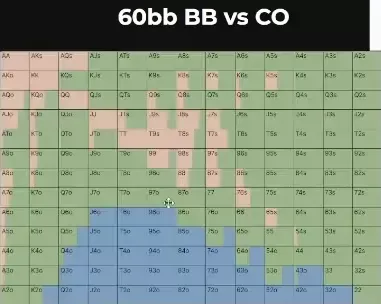
There are obviously very profitable calls because there are no players behind and we already have one big blind in the middle, right? So we want to make sure we find all these calls versus cutoff. And then the 3-betting is interesting, right? Because it is polarized but it is not so polarized. We don't want to take a hand like Ten-Four suited or Seven-Three suited because we're still 60 big blinds deep, they will still be calling.
So it is actually quite important – one thing that I think has been established, that was a time, if you don't go too far back, people were just 3-betting value. Big blind 3-bet percentage of the average American when you play at the WSOP, it looked something like Jacks plus, Ace-King, and you know, you saw like 4, 5, 6, 7% 3-bets and you could just fold everything against that.
And I think what is kind of important now is that you find the right combinations. That you find those suited connectors, you know, the Eight-Nine, Seven-Eight, Ten-Eight, Ten-Nine, Jack-Eight, Ten-Seven suited hands. They just play so well, especially when they perform in this overall range where you're protected by the stronger hands that you also have. So these hands are basically the perfect balance between you want to be polarized so you don't mind, you know, if you 4-bet and then you can fold those hands, but at the same time you want to have playability.
3-Bet Ranges On Different Stack Depths
All right, so now we can look at different dimensions. Before, we looked at the dimension of what is if positions change. Now we look at the same positions but with changing stack size.
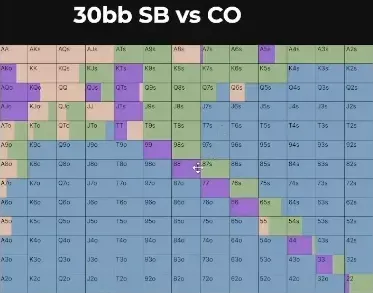
Now what we see here is we have these value hands that we 3-bet, right? The bluffs come from not such a polarized 3-betting range, but polarized, right? Like there is a gap, but the gap is not too big. Actually, we don't take Eight-Nine suited in this regard, we take more offsuit hands, and then we have jams. And that's interesting, so the Fours and Sixes and Ace-King off, Ace-Queen off in this scenario are just being jammed.
What change will we see, same position now 30 to 60? What will change? So we had 60 big blind small blind versus cutoff.
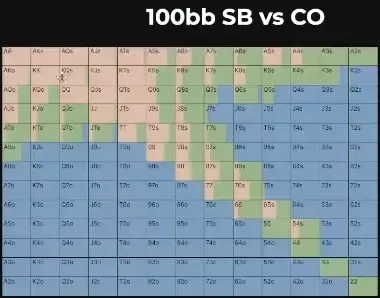
It obviously looks the same, but now how does it change to 100 big blinds? The deeper it is, the more nut-heavy is important.
Now what do we see? And this is kind of interesting, right? We basically have no flatting range of this, let's say the good stuff anymore, right? Very, very linear. There's no jams versus the 3-bet, we don't get pushed off our equity. You know, we can 3-bet call those hands, just very linear, but also we get called, play these postflop spots.
So, you know, and I think this is always interesting when we look at small blind versus cutoff. You know, if we go to 100 big blinds, we look at cutoff and then we look at small blind 3-betting, and then we look at cutoff, for example, he 4-bets. You know where we continue these hands, you know a lot of this stuff versus quite some players you can't, but you know you can see, oh Seven-Eight suited is 0.5 big blind call.
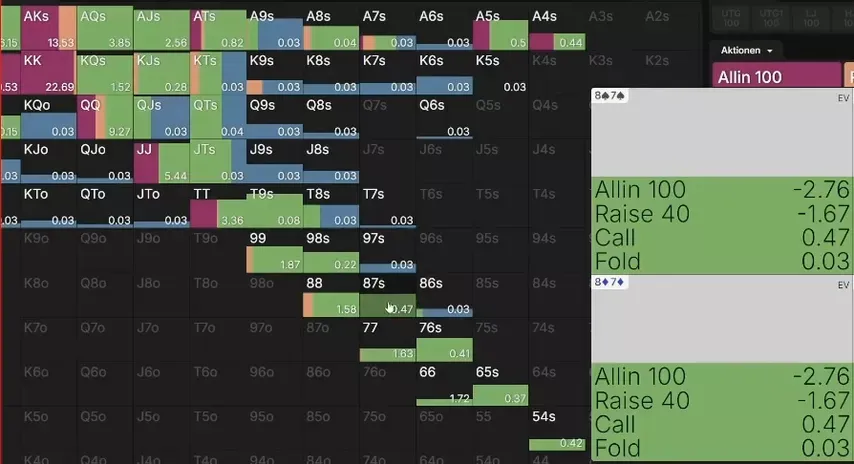
Now you know they actually can continue quite well. Queen-Jack suited is mostly a fold, but this is I think always interesting to see is like, you know, we 3-bet those hands and then we call them. I think a good methodology to keep in your head is the deeper we get, the more linear it gets. And having this in mind like okay, what is he, you know, how often is he going to 4-bet really drives which hands we want to call and which ones we want to 3-bet.
3-Bet Ranges Factoring in ICM
To all the people I work with or talk strategy with sometimes, I just want to highlight here again these ICM sims I would always take them with a grain of salt. The way they're solved, they just cannot take future play properly into account. I think the real game changers are going to be AIs that are going to be much better or LLMs that are going to be much better at kind of running multiple sims, basically, in a row. This type of way to solve for chip value I think is flawed. It can give us a good hint, a good understanding, a good directional understanding sometimes, but I just take this with a grain of salt.
So the idea here is we run this sim and we look at ICM value of chips and do that with different player pools remaining. So we have 50% player pool remaining. What we see is it's more polarized than chEV.
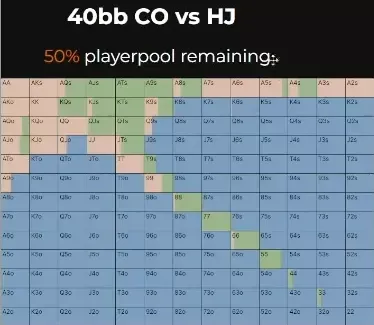
We're just 3-bet more polarized and then we compare. What we see is it's kind of obvious where obviously if losing chips becomes more painful, we are just going to call less of the bottom stuff. Like everything that's 0.02 big blinds now is zero or minus 0.02.
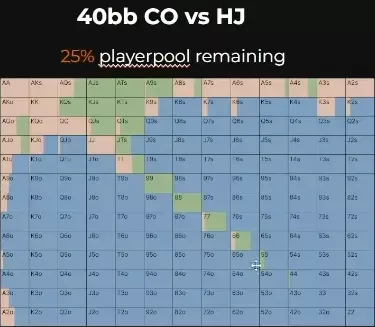
So slightly less calling, more polarized, and blocker-heavy 3-betting. We just play less postflop, there's just less incentive to play postflop.
And then on the final table, similar calling. I mean, here obviously it really depends on the stack sizes of the other players. I think this is probably everyone 40 big blinds.
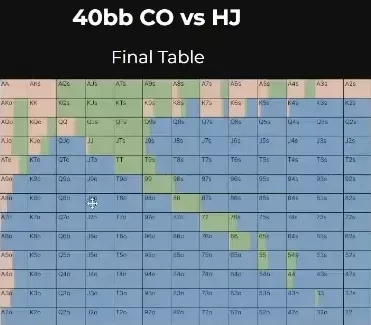
I actually don't remember exactly which distribution this is, but again similar approach, blocker-heavy approach.
Value becomes much less now and this is the interesting part. I think if you look from 50% to Final Table, your value threshold goes higher. This is already a thing that I'm fairly certain in some spots will just not be this way. We will not call Ace-King off or, you know, not in this frequency, or we will not call Jacks. We will just go or Queens never and we just go broke and winning chips is slightly more valuable than what ICM attributes. So I think we play slightly more for chips. So I think these solutions will look slightly different in a perfect world, but you know, we get the idea that we polarize and we don't want to flat too much. And I think that's the idea here in ICM. And as we can see, that can actually be very different.
You know, try to not take those sims as I look at green and orange and what I'm supposed to do. Just really try to understand what they're saying so that you can change them because what will happen is if you really understand, you can also really heavily exploit because I can see already now, you know, certain players they just play certain charts and it you can see in practice how bad it is.
Chip lead is worth more than ICM suggests. It depends on the circumstances but yes, most of the time I believe that especially if you really can leverage it. I think that's important, like especially if we can put on long consistent pressure. That's mostly I think what I really like.
Importance of SPR
The next important topic is the importance of stack-to-pot ratio and there's a few different things that come with that. And one is the lower the lighter we stack off, that's kind of obvious. The higher the SPR is, the more important position is. Why is that? Equity realization. Just in position we can leverage more. Generally, we see more checking when deeper stacked. Again, when we have more leverage, polarization becomes more important. Because what do we leverage? We leverage the best hands. So in between we can just go less light for value, means more polarized, means more checking, kind of self-explanatory.
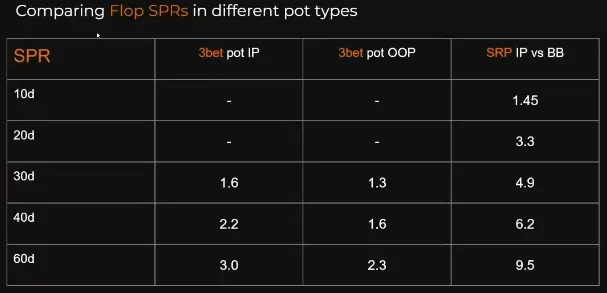
A big population leak is being able to stack off light, especially in chipEV. So if we compare SPRs, we can look at how deep we are and one thing that I find interesting is comparing 3-bet pot SPRs to single raised pots. So if we look at in position with big blind for example, and what we can see here for example is okay, what is comparable. And so when we have 40 big blinds deep in the single raised pot, it's comparable to 14 to 40 in a 3-bet pot. So 2.2 and that is quite interesting to see. Okay, like 10 big blinds deep open raising is similar to 30 big blinds deep 3-betting, obviously depending on how we size.
So that's also kind of cool to see is where can we draw similarities between how deep we are starting the spot.
Now postflop, and this is very important when we look at 3-bet pots, our strategy really depends on these SPRs or at least it's an easy way to get a good idea of what our strategy is and it can help us build a framework. So when we're thinking again like how do I know when I'm in a spot what to consider and what framework to even think in, and I think SPR can really help with that. Is okay, SPR is one and a half, these are my sizings or these are the things I want to think about. That can be very helpful.
So I would really recommend you to think about SPRs. Okay, I'm 40 deep, I 3-bet this size so SPR is 1.5. This can be generally I think very helpful is okay, when SPR is four, you know, I want to check. When SPR is one, I have shoves. I have so it's easier to connect it this way I would say. So I'm going to show you some different betting frequencies over different SPRs and we're going to look at two different spots. So we're going to compare C-betting frequencies and 3-bet pots in position.
Okay, we are looking at 30 big blinds and we will compare to 60 big blinds. And again, we utilize a strategy where we lock one factor and then we take one dimension and look at the distribution or the development. So we look at 30 big blinds and then we look at 60 big blinds and then we see, okay, how's it changing when we get deeper?
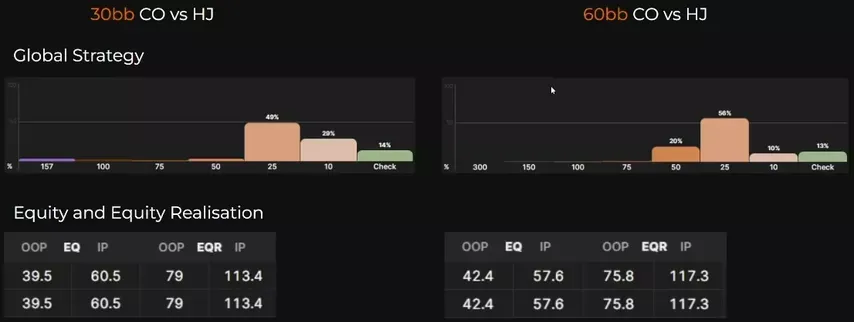
So what we can see is the equity distribution. We have 40% equity and this is the strategy for in position. Okay, so we're cutoff against hijack and what we do is there's a lot of small betting and very little checking. How is it different to when we get deeper? And this is interesting. When we get deeper, we see equity realization. That is one of the main things. I think this has been a concept that a few years ago, or also when you're new to poker, it's not so clear, but that's a big driver especially in 3-bet pots.
We have less equity obviously, but we also have shitty equity realization and it's kind of a multiplier. Because if you go in with 40% equity but you only have 75% equity realization, you only get three quarters of that 40%. You only get 30% of the pot. And that's a very important part of this whole thing, that it's not only about equity, it's also we can't really realize the equity. So we need a little bit more equity because our real equity realization is worse.
What we see there is same amount of checking and there's no particular explanation for this now, but what we see, and I think that makes a lot of sense, is higher SPRs. There is a particular explanation: higher SPRs leads to larger bet sizes.
So there's somewhat of some level of geometry in there where we choose the sizing according to how much we have left. And that's what we see here. When it gets deeper, we see the sizing being introduced that is 50% of the pot. And what happens there, and I'm fairly certain about that, is we will see a more polarized approach. We will see hands in there that want to put in the most possible chips on this particular street because they hurt the most from the equity shifts. Normally that's one category worse than the nuts. So it's like the strong hands that want to get it in now basically, or as many chips as possible because they want the SPR to be as low as possible on the next and on the next street.
Now what happens when we're out of position? We see okay, equity already little bit worse, equity realization, and this is interesting, equity realization is the same even though we have range advantage.
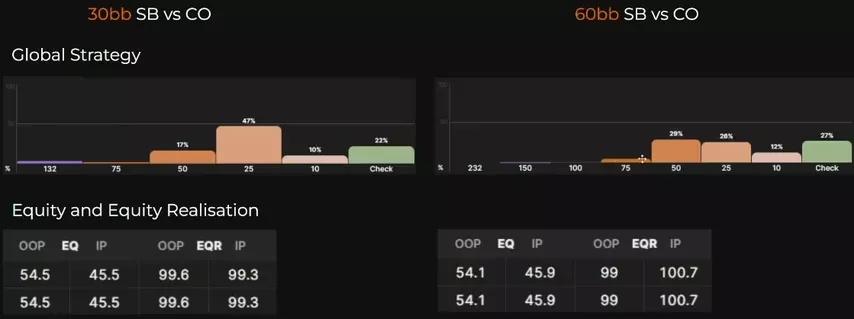
But betting is similar, but what do we see? Wow, you know, we see okay, there's some bigger sizings already. And this, ladies and gentlemen, this is the out-of-position factor. Because now in the other scenario, it's good for us to have a higher SPR. It leaves us options, it gives us maneuverability. But here in this case, often it's not good. We actually want to limit options in position because what we've seen is the deeper we are or the more SPR, the better for the in-position player. So actually what you see here, this bigger sizing already happening is, damn it, we want to take the options from the in-position player.
And now if we take a look at the next one, basically extremely similar but it will just be more drastic. And as you can see, that's exactly what's happening is much more goes into this polarized approach. Into bet 50, you will see some bet 75.
Postflop – Aggregate Reports
All right, now postflop aggregate reports, I really, really love it and it's very, very helpful to build a framework. So you can also change to table if you prefer that view and you can browse this way. You can filter, for example, I want to see the ones that get checked the most.
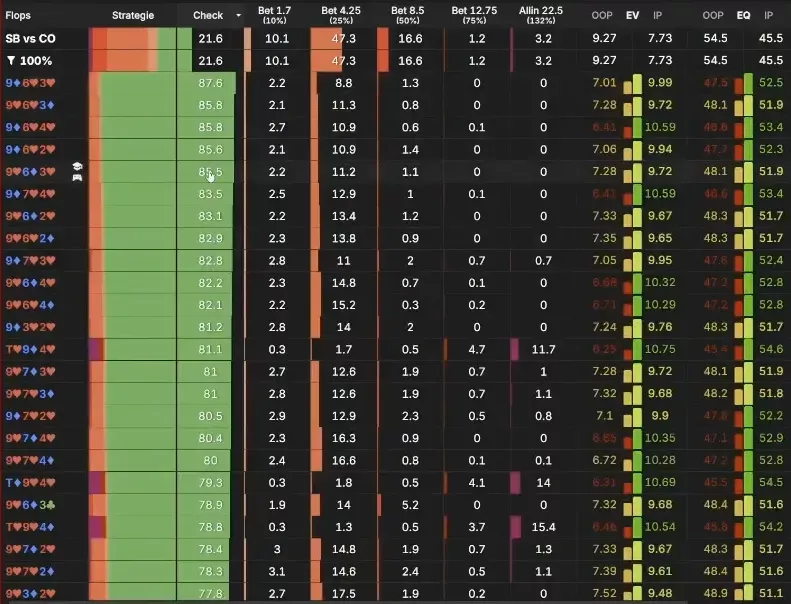
And you're like, okay, in these type of structures, I'm really checking a lot. Or you know, I want to see all the boards where all-in is the most.
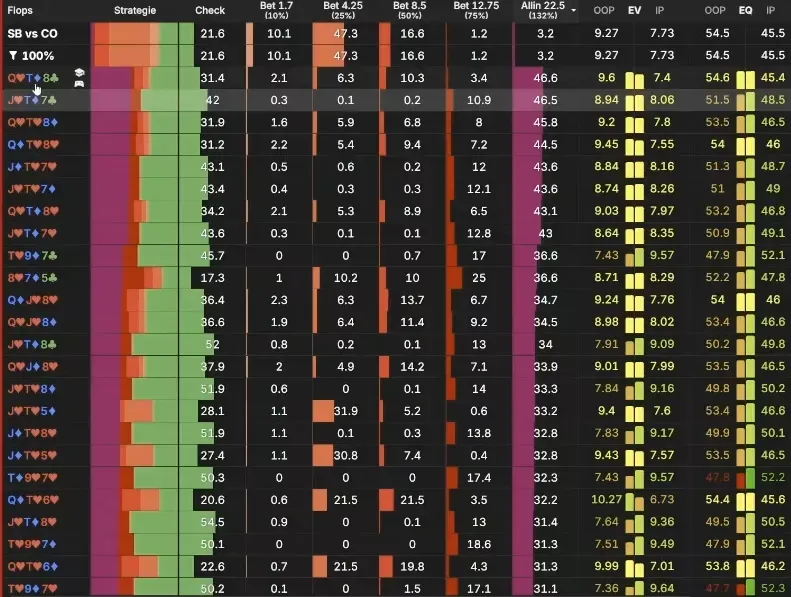
Very cool feature I think to look at and I think one of the best ways to get a better understanding of spots.
So there, what I highly suggest is just drill these spots. So you can study those reports, you get a better understanding. You know, I really just wrote down notes basically, with the idea, "Okay, I have 30 minutes, what are the most important high-level thoughts of looking at this report?" And then I just drill it and see my mistakes and then revisit it. So that's been very helpful.
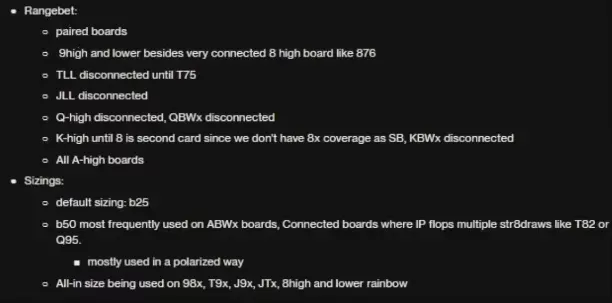
You can see how those notes would look like, just writing down things that are important takeaways. And I think that's a really, really good way to learn these spots.
Opponent Personas
Actually, just to quickly round up because I found this funny, Fabi created some characters in the coaching because they were talking about live poker adjustments because they were playing in Marrakesh. And he gave some ideas and he created some personas.
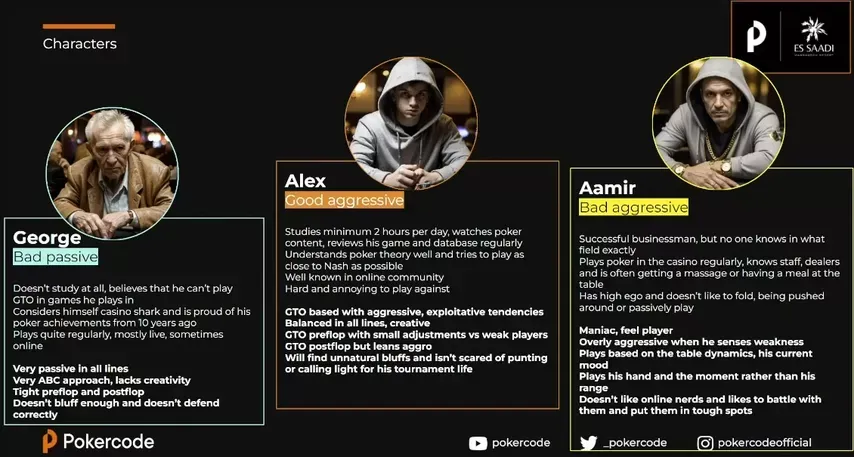
And I think that's very important. What's interesting there is, what are, you know, if you think in these type of categories and become more granular, it actually become, you know, you can become much sharper around this. Like what do we do against 3-bets for example?
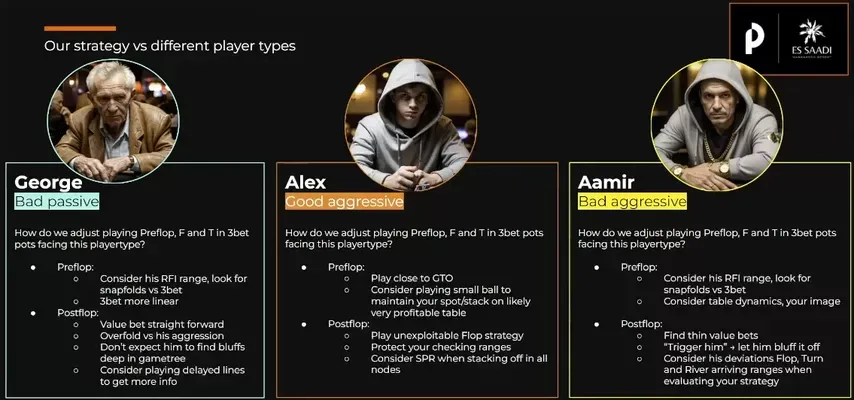
There's lots of spots where I'm just auto-folding, like really obvious defense where if he 3-bets 6% from the big blind, you know, how most of these bad passive players do, you just have to fold 75-80% against the 3-bet and most players are just not disciplined enough to do that. So this type of stuff I think are just really good live adjustments against certain players and they talked about that and gathered some input and I found that really nice.







